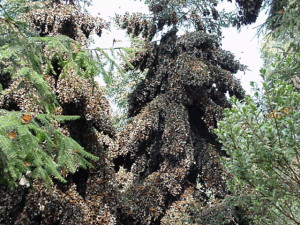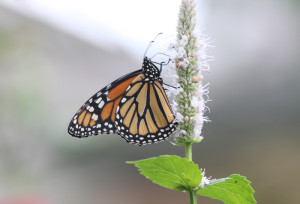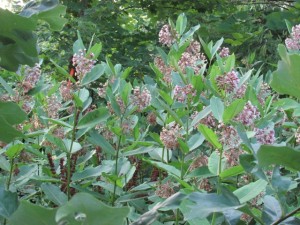This post originally appeared on the Sieve.
The once-mighty monarch butterfly migration—an extraordinary natural phenomenon that passes right through our neighborhoods and fields—has been reduced to a trickle. Where were you all summer, did you notice?
For how things used to be, here is Annie Dillard describing the event in Pilgrim at Tinker Creek, published in 1974:
The monarchs clattered in the air, burnished like throngs of pennies, here’s one, and here’s one, and more, and more. They flapped and floundered; they thrust, splitting the air like the keels of canoes, quickened and fleet. It looked as though the leaves of the autumn forest had taken flight, and were pouring down the valley like a waterfall, like a tidal wave, all the leaves of hardwoods from here to Hudson’s Bay.
Dillard seems to be describing a scene of almost unimaginable natural wealth. The world had such an excess of raw material that it could make monarch butterflies not by the ones and twos, but by the millions. Indeed, estimates of the number of monarchs that used to overwinter in Mexican fir and pine forests range up to a billion. In pictures, the trees seem to be literally dripping with butterflies.
I fear that in the four decades since Pilgrim, we have become accustomed to an invisible poverty. One can understand the intensity of seeing the migration in full force, as Dillard did—of being left feeling “inundated, drained.” But what is the experience of not seeing the monarch migration? An uneasy emptiness? A directionless longing? Only those people whose work involves seeing—namely the gardeners and the scientists—seem to realize the enormity of what is happening.
Case in point: this year, I have seen a total of one monarch butterfly. Having been told they were scarce, I went outside and watched it flutter, fold its wings and drink nectar from a flower, and fly away again. I felt both pleased with my brief connection with the creature, and sorry for its solitude. But then I went back to being distracted by many other things; I admit I haven’t been focusing much on monarchs.
Then again, I presume, neither was Annie Dillard. She was just looking out her window.
Among gardeners, however, even a single monarch sighting is now enough to set off a volley of emails. Gardeners these days are all gaga about pollinators, and now in late summer, their joe pye weeds, ironweeds and black-eyed susans swarm with bees, wasps, butterflies, moths, even hummingbirds. But lucky indeed is the gardener who spies one of the rare orange and black Technicolor beauties—the butterfly which, in Dillard’s thrilling words, appears at rest “like a fleck of tiger.”
Gardeners focus on the small scale; scientists look at the big picture. And many–though not all–of them are also documenting a monarch impoverishment. Probably the most startling evidence comes from Mexico, where the forested area covered by overwintering monarchs has fallen precipitously in recent years; if the trend continues, the population will soon reach zero.
Scientists have identified several factors behind this decline. Perhaps most obviously, the monarch’s overwintering habitat in Mexico has been reduced by logging, although what’s left is now protected. Unusually hot weather has also taken its toll, drying out monarch egg sacs and the nectar plants the adult butterfly relies on for food. But more than anything, the monarch butterfly’s fate is wrapped up with that of a genus of plants—Asclepias, or milkweed—because it is only from milkweeds that its caterpillars feed.
Isn’t it risky, you might ask, for a species to stake its evolutionary fate on one type of plant? It would seem so, but for millions of years this gamble apparently paid off. Common milkweed is a hearty plant that, as its name suggests, grows and reproduces readily with no human intervention; it was ubiquitous on the prairies that long occupied the central part of our continent. But as anyone who has visited the Midwest knows, the diverse prairie ecosystem has been almost entirely replaced by corn and soybean monocultures. Even this might not be such a problem for the monarch if milkweeds could grow in field margins and between crop rows, as they used to. But corn and soy are now mostly planted “Roundup-Ready,” meaning that farmers can douse their fields with unprecedented quantities of herbicide. The milkweed seems to have become a casualty of Monsanto-enabled agricultural efficiency, and migrating monarchs now find themselves flying over vast food deserts.
It’s a troubling scene, but there is hope. Gardeners are now dedicating themselves to help the milkweed, and thus the monarch, make a comeback. If milkweed is not going to sprout in prairies and farm fields, well, by golly it will grow in the nation’s suburbs. My mother, a native plant landscaper in Kentucky, recently became the 6,895th person to plant a “monarch waystation,” which is a habitat containing a certain number of milkweed varieties and other nectar plants. For her efforts, she received a certificate and a sign from Chip Taylor, the University of Kansas biologist and monarch butterfly devotee who launched the waystation program. Taylor and his conservation compatriots are betting that they can create managed ecosystems to replace the natural functions we’ve lost, though so far the monarch has continued to decline.
In the end, the fate of this project depends on how well scientists and gardeners are able to see like a monarch. For the butterfly, the world is milkweed, pollen plants, Mexican fir trees, other monarchs, birds, North, and South. Everything else is just plastic—worthless. In our complicated human world, by contrast, monarchs are just one of thousands of pieces, and hardly the most vital to our survival. It is thus perhaps not surprising that we lost sight of them in all their abundance, and blithely obliterated their food source. It is impressive we were smart enough to piece together their life cycle and migration routes, and to see the connection between herbicide and butterfly decline. And it is inspiring that thousands are now putting their gardens in service of this regal insect. It will be years before we know if they have succeeded, but theirs is unquestionably a noble effort.
Gardeners and scientists know that nature has given us riches beyond measure. Evolution needed billions of years to create the beautiful and charismatic monarch butterfly, which has now thrived on this continent for a few million years. And yet this butterfly may all but disappear within one human generation, without even being deliberately hunted like the passenger pigeon. What are we to make of this careless catastrophe? As it has since the passenger pigeon vanished, life is going on. We can presumably live without the milkweed and the monarch, and even without the birds that feed on monarch caterpillars. But why would we want to? Why choose poverty when we were given wealth?
To avoid that dismal fate, we need to be willing to see—to really see—what a poor world we are in danger of creating.


